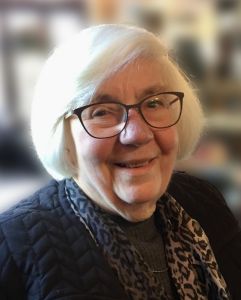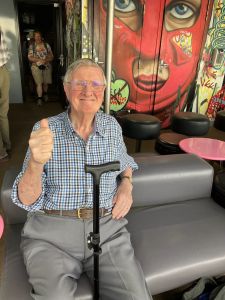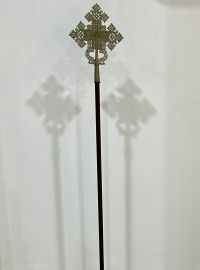Autumn 2024
| From the Minister | From the Editor
Welcome to our Autumn edition of Mark the Word. Autumn is a lovely time of year, with a mixture of warm days and cool nights (except for last week!), and the beautiful changing colours on the trees. The days are shorter and there is a feeling of packing away summer and getting ready for winter. Even though the Lent and Easter period in the northern hemisphere is in Spring with the associations of new life, having this liturgical season during Autumn in Australia somehow feels more appropriate. We have been blessed again with our congregation responding to our call-out and supplying us with a range of articles, including one remembering our faithful servant, Eleanor Pugsley who passed away recently and another acknowledging Greg Hill and his tireless work as Parish Administrator for MtE and Hotham Mission. We hope you enjoy reading them. May Easter bring you joy as we celebrate the resurrection of our Lord. from the Editorial Team: Rod Mummery, producer; Vicki Radcliffe, Editor and Rosemary Wearing, Co-Editor. Vicki and Rosemary wish to thank Rod Mummery for all of his constant help and advice in getting MtW prepared and published each quarter. As well, we thank Donald Nicholson for selecting the wonderful music for each edition.
From the Minister We’re now eight months or so into our new home at the CTM and, after our planned gentle slide into the new place, we have begun to move on a number of fronts towards making the place more “our own”, and linking into the CTM and wider community around the university. Conversations have begun with a couple of the UCA colleges about potential links to the congregation, and we are looking forward to the arrival of the new UCA chaplain (Rev. Brendan Byrne) at Melbourne University and discovering how we might assist in that ministry. We have begun work on replacing the Yuma (worship space) chairs and acquiring some bespoke liturgical for use by ourselves and others in Yuma worship services. The CTM leadership continues to be responsive to our requests for this or that occasional thing and are welcoming of our suggestions; we hope to improve signage of the congregation’s presence and can communicate directly with the CTM community about upcoming MtE events. In addition to our normal Holy Week and Easter services, we will also take the lead in a short service each day of Holy Week in the CTM chapel, with CTM staff. Apart from all these developments, the “usual stuff” continues, including the Lenten studies (these a getting a little bigger each time!) and tracking a number of matters still to settle post-sale of Curzon Street. Not least among the latter is a transition (we hope!) of Hotham Mission into a new ecumenical partnership with another congregation in North Melbourne as we farewell Greg Hill after nearly 20 years of service to the Congregation and its Mission. This issue of MtW comes out a couple of weeks before quite an early Easter, making for an “action-packed” (very busy!) first few months of 2024. I hope that you’re looking forward to a year full of life in the congregation, and I pray that the next few weeks into and through Easter will help us understand who we are, how we are loved, and what we can yet be, by the grace of God. News from Church Council Since the last edition of Mark the Word in mid-December, the Congregation was pleased to celebrate its first Christmas in Yuma Auditorium at the CTM, which now feels more and more ‘our place of worship’. Services in January were well attended, and during Craig’s vacation, continuity was maintained thanks to those members who preached, served as liturgist and performed Sunday duties including Peter Blackwood, Robert Gribben and Rob Gotch. On Sunday 18 February the Council gathered after morning tea for its first meeting of 2024. After considering the reports and recommendations of the Minister and the Finance and Property Committee, and following BYO lunch (from school lunchboxes!), there was ample time to discuss and seek to discern the life and mission of the Congregation in its new location, this year and beyond. We agreed it was important that the Congregation soon review its life in an informal way, and that periodic meetings be held with representatives of eLM (equipping Leadership for Mission) and Pilgrim Theological College. Some next steps in planning will be to make contact with university neighbours (Queen’s, Ormond and St Hilda’s Colleges) and ecumenical neighbours (such as St Carthage’s Parkville). Our connection with the Church of All Nations Carlton will be strengthened on 28 April, when CAN will combine with us at the CTM for the Mark the Evangelist worship service and lunch. The Congregation recently received the news of the death on 22 February of Eleanor Pugsley – much loved friend and member of College Church Parkville and then the amalgamated Congregation of Mark the Evangelist. Rod’s article below commemorates Eleanor, her life and her faithful service among us and beyond. Comments, queries and suggestions are welcomed by the Church Councillors: Vale Eleanor Margaret Pugsley
Her father was a bank manager, so in her early life she lived in several places – Dimboola, Prahran (where she started school) and then Launceston, Tasmania where she completed her education. In 1956 she came to Melbourne to attend Melbourne University where she completed a Science Degree, followed by a Diploma of Education. She was resident in University Women’s College (now University College). As there was no chapel in the college Eleanor and her friends went across to Queen’s Chapel for worship. There she met Ian Pugsley. Ian and Eleanor were married in College Church, Parkville (by Calvert Barber) in 1st January 1960. They continued to worship at Queens, but when children arrived they decided it was better to worship in a congregation with families and decided upon College Church. Thus Eleanor’s long membership of this congregation began. Eleanor taught for two years before becoming a stay-at-home mother for her three older children. When they were in primary school she returned to teaching – at Debney Park High School (now Mount Alexander College [MAC]). She continued teaching there until the birth of her fourth child.
Eleanor was a warm and caring person, quietly providing pastoral care to members of the congregation – directly, or more often behind the scenes making sure appropriate care was given. Hospitality was another of her qualities – many a visitor to College Church was encouraged to walk down to the Pugsley home for a sumptuous Sunday roast and numerous church meetings (always with refreshments) were hosted by the Pugsleys. Eleanor served the wider community by volunteering in a wide range of areas – including teaching English to mothers in their homes, her children’s schools, the Genealogical Society of Victoria (where she later became a staff member and member of its Council). Eleanor’s warmth and friendly smile will be missed by all who knew her. We give thanks to God for the privilege of knowing her. ‘Heavenly Beings’ – A Visit to MONA I couldn’t believe it. An exhibition of 152 icons that lasted for 6 months seemed out of character. My image of the Museum of Old and New Art in Hobart was that it presented contemporary work that I considered debased and designed to shock.
My daughter, Lynette, caught me reading the catalogue and offered to take me. It was extravagant, but my interest was compelling. So, we went. First, Lynette booked everything with her telephone. The total dominance of digital technology was to be an oft repeating theme. I feel there is a new world that has left me behind. Things got complicated at airport security and somehow, I lost my belt. At the ferry terminal we discovered our bookings were dated for last year, but it got sorted. The lady in charge looked at my walking stick and asked if I could climb the 99 steps from the ferry to the museum entrance. I used the tunnel instead. To compensate for our vicissitudes there was the sunrise. Our room looked due east, over Constitution Dock and down the Derwent. I drew back the curtains to discover the whole sky was alight with colour, and, for good measure, the bright orange was reflected in the water.
Most of the icons date from the 16th and 17th centuries, and they are the sort of icons that the faithful might have in their homes. If you go to a book of icons, you will usually find the prototypes, or famous examples, of particular subjects. But here they are what I call derivatives. For example, the Virgin might now be lovingly holding the hand of the Christ child, but in doing so preventing the hand giving a blessing. The faces are more humanistic. St George, on his white horse, might now have a princess looking on. The Face of Christ on a Towel might now have Veronica holding up the towel. There are a lot of icons from Crete. Many date from the time when Venice ruled the Mediterranean and show how the culture of the Western Church mingled with the art of the East. The colours are strong and folds are done differently. Iconographers from Albania were innovative also. These can be compared with icons from Russia and Greece which are more strictly Byzantine. An atmosphere is created by the soft playing of Orthodox liturgical chant, at one stage by an all-female choir.
While the comments are well researched, there could be more attention to the theology being expressed. The significance of the Annunciation being displayed on the Royal Doors could include the link between God taking human form through Mary and the way the elements, which pass through the doors on their way from the altar to the people, enable God to become human through the body of Christ today. Was my short trip to Hobart extravagant? Yes, it was. But it was worth it! The Other Creed On Sundays at the Eucharist, Anglicans always use the Creed of Nicaea (325/381 CE), whereas the Uniting Church may use an ‘affirmation of faith’, which is usually a modern one, the best (in my opinion) being the one crafted in the United Church of Canada in 1968. The Uniting Church has one of its own, using words from its Basis of Union, ‘We are a Pilgrim People’, but the Beatitudes or the Prologue of St John’s Gospel are also alternatives. However, at Baptism, we both use the Apostles’ Creed, being careful to have the apostrophe after the ‘s’, since an ancient legend has it that each apostle (Matthias replacing Iscariot) contributed an article. Its real universal acceptance lies in the belief that it authentically teaches the apostolic faith. It has an entirely different history from the Nicene (hereafter ‘NC’), though both began as statements of faith at baptism, and it’s possible that the Apostles’ (hereafter ‘AC’) was originally in the question-and-answer form we rehearse at our own baptismal rites. The AC’s origin is in Rome, and it belongs to the Western Church; the Orthodox do not accept it. The NC is essentially an ecumenical creed, devised by a Council of the whole Church, meeting in a town in the east of the Roman Empire (Nicaea) with a western bishop (Ossius of Cordoba) in the chair as delegate of the emperor and a gathering of bishops of both east and west. Both the Latins and the Greeks called it the ‘Symbol’, in the sense of an ‘identifying mark’ of the Christian faith. St Ambrose of Milan refers to an old Roman creed in a letter dated 390, the predecessor of the AC, and it was probably based on Jesus’ Great Commission in Matthew 28:19 (‘Go-Teach-Baptize’), which names the Trinity. Thus, it has always been associated with baptism, the AC being in the form ‘I believe’ of the individual candidate, whereas the NC, being the statement of a Council, begins with ‘We believe’. The AC evolved slowly, but its language and expression can be found in many of the principal theologians of the late 2nd – 3rd CC. The text we recognize was passed around the Christian world and further developed in the 5thC in Southern Gaul, until Charlemagne regularized the Roman Liturgy in the 8thC and imposed it throughout his dominions. The AC is shorter than the NC, but the former was not part of defending the faith against the heresy of Arius, which required refutation. Both our churches use a modern ecumenical translation, which was the work of the English Language Liturgical Consultation (ELLC), on which, inter alia, Australians Evan Burge, Ron Dowling, D’Arcy Wood and I sat at various times. The AC affirms that Jesus was ‘conceived by the Holy Spirit, born of the Virgin Mary’. Whereas the theological disputes over the two natures of Christ at Nicaea led to the NC’s – to my mind, beautiful – ’was incarnate of the Holy Spirit and the Virgin Mary and became truly human’. When we were doing this new translation, the English-speaking world, for whom we were working, was trying to overcome the narrow meaning of ‘man’. It was thought that ‘and became man’ introduced a new confusion; ‘became human’ means something quite different, and thus, after much debate, ‘truly human’. Note too, that Mary is given an equal partnership in the incarnation with the Holy Spirit: ‘the Creed wants to make it perfectly clear that Jesus, the incarnate Son, is completely God and completely human, and that the operation of both the Virgin and the Spirit were equally essential’ (Evan Burge). Thus, the great mystery is set forth in both creeds. Another of its unique features is the phrase, ‘he descended into hell’ which is based on Ephesians 4:9, literally, ‘he descended into the lower parts of the earth’. While ‘hell’ is more explicit, it unnecessarily implies a whole set of beliefs which the original word ‘infera’ doesn’t, so the ecumenical version which both our churches use is ’he descended to the dead’, allowing a wider interpretation (the churches vary on the meaning). Another is affirming the Church’s belief in ‘the communion of saints’ which NC does not have. The translation is familiar and there seemed no good reason to change it, especially as it allows a breadth of meaning. ‘Saints’ reminds us that the Church embraces a holy people from the past, present and future. Given the truly horrendous machinery the Roman church uses to declare someone a ‘saint’, it’s worth noting that the New Testament accords the title chiefly to the local community, those who little deserve such a title, but were claimed by Christ in Holy Baptism. Over the centuries, some of those local saints became known and venerated beyond the parish boundaries, as it were, but there were, and are, by God’s grace, many more! ‘Communion’ translates the Greek koinonia which is variously given as ‘communion’, ‘community’ or ‘fellowship’. Note also that this follows the affirmation of ‘the holy catholic church’, of all Christians everywhere. The Puritan end of Anglicanism and the Congregational end of the Reformed Churches apply it to a quite precise congregation of saints, like St Mary’s or Mark the Evangelist’s gathering of worshippers, so in that sense, it is more specific than ‘Church’. Thus ‘catholic’, from the Greek ‘katholikos’ (kath-holos), ‘throughout the whole’ [world]. There is also a variation between the AC’s ‘I believe… in the resurrection of the body’ and NC’s ‘we look for the resurrection of the dead’. For the AC’s purposes, ‘body’ seemed ‘a more adequate way of expressing the totality of the resurrection’ than the original phrase which is ‘of the flesh’ (quoting Dr Burge’s fine commentary). Our body is an essential part of who we are. To summarize a large question, not only our ‘soul’ will be raised, but the wholeness of who we are – and we will be given a new body fit for life with God. Read 1 Corinthians 15 carefully! For some Christians, it invites a marking of their body with the sign of the cross at this point in its recitation. Reading: The Rev. Dr Evan Burge, then Warden of Trinity College, Parkville, wrote the commentary on behalf of the ELLC in Praying Together, Norwich: The Canterbury Press, 1988. They represent the growing consensus across the world of English-speaking churches in their desire to pray publicly with each other in the same language, including the Creeds, the Lord’s Prayer, the common liturgical responses (Kyrie eleison, Sanctus and Benedictus &c) and some canticles (Magnificat, Benedictus &c). Farewell and best wishes to our Parish Administrator and dear friend, Mr Greg Hill Greg came to Mark the Evangelist nearly 20 years ago, in 2005. He has given us all the years from then till now, of devoted service. And, goodness me, how much we are going to miss him. Greg came to us after a successful career in a large company. His interview panel could hardly believe their good fortune – that someone of this calibre would be interested in the workings of a congregation and a small welfare agency. But this was exactly what he was interested in. A devout Catholic, whose faith was important to him, he saw the position as one where he could give service to both congregation and welfare service as a faithful disciple. None of us could have predicted the challenges that Greg would be part of in facing and solving the various challenges in Hotham Mission, not to mention the changed thinking about what was going to be decided about the Curzon St property and finally, the selling of that large property. We have needed every bit of expertise that Greg has brought with him. We know Greg as a very well-rounded character. He can talk footy (try to get him NOT to talk footy if his beloved Richmond is doing well!). He’s devoted to his family – to his children and to Isabel, his wife – and to his wider extended family. His love and affection for them all is evident in his conversations. He’s interested in the economy, in politics, in community, in questions of current affairs, if often bemused by the folly of the human race. Then, there is the side of him that many of us have experienced – his passionate concern for those less well off – kids struggling at school, asylum seekers, homeless people, the mentally ill, those recently arrived in Australia and not speaking English, and those of different ethnic backgrounds who need support settling into a new country. Whether it has been in the gentle compassion to the gentleman that sometimes slept on the verandah of the cottage at Elm St, or the caring for the office and Hotham Mission staff, or working tirelessly to make sure there was funding for the Hotham Mission programs, or supporting ideas about how to better reach those who needed Hotham’s services – always at the heart of what Greg has done has been concern to make the lot of those around him better. We all know fair weather friends, but Greg is able to be a foul weather friend – there when the going is tough, providing good and thoughtful advice, thinking things through, knowing there is complexity, but always aiming for what is going to improve things – whether that be programs of the mission, governance of the congregation and Mission, organization structure and processes of both, personal relationships within both settings or personal well-being. Greg has been a gift to us. One for which we thank him and thank God. Easter Services
Holy Week services, 12.30pm Monday 25th, Tuesday 26th, Wednesday 27th and Thursday 28th in the CTM chapel; 20 minutes or so! Maundy Thursday — March 28 — A Tenebrae service around St John’s Passion, in the CTM chapel, 7.30pm (gathered only, not live-streamed) Good Friday — March 29 — 10.00am (gathered and live-streamed) Easter Vigil — Saturday March 30 — 8.00pm (gathered only, not live-streamed) Easter Day — Sunday March 31 — 10.00am (gathered and live-streamed) Normal service times on Sundays (10.00) after Easter |

 Eleanor was born in Echuca on 20th May 1938, the daughter of Harry and Nell Humphris.
Eleanor was born in Echuca on 20th May 1938, the daughter of Harry and Nell Humphris. Over the years Eleanor’s contribution to the church and this congregation in particular was significant and wide-ranging. The following are just a few examples: teaching Sunday School, membership of the worship planning committee at College Church (when there was no minister); membership of the Interim Hotham Parish Council (immediately prior to Union); committee work that led to the creation of North Melbourne Social Services, chairperson of Courtney Youth Services (a hostel for troubled young women, a project of Hotham Mission); the Mark the Evangelist Space and Furniture Committee. She also served on the Board of Penleigh and Essendon Grammar School.
Over the years Eleanor’s contribution to the church and this congregation in particular was significant and wide-ranging. The following are just a few examples: teaching Sunday School, membership of the worship planning committee at College Church (when there was no minister); membership of the Interim Hotham Parish Council (immediately prior to Union); committee work that led to the creation of North Melbourne Social Services, chairperson of Courtney Youth Services (a hostel for troubled young women, a project of Hotham Mission); the Mark the Evangelist Space and Furniture Committee. She also served on the Board of Penleigh and Essendon Grammar School. While the selection of icons is wide ranging, there are gaps. For example Orthodox Churches display icons of 12 festivals on an iconostasis, but I could only count 10 represented here. I didn’t find Lazarus, or Pentecost.
While the selection of icons is wide ranging, there are gaps. For example Orthodox Churches display icons of 12 festivals on an iconostasis, but I could only count 10 represented here. I didn’t find Lazarus, or Pentecost. Passion Sunday — March 24 — 10.00am. A reading of the Passion narrative (St Mark), with Eucharist
Passion Sunday — March 24 — 10.00am. A reading of the Passion narrative (St Mark), with Eucharist